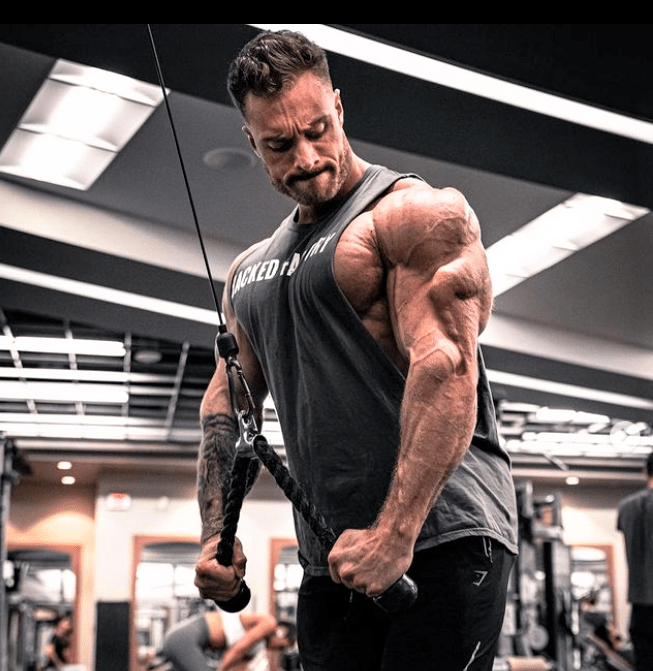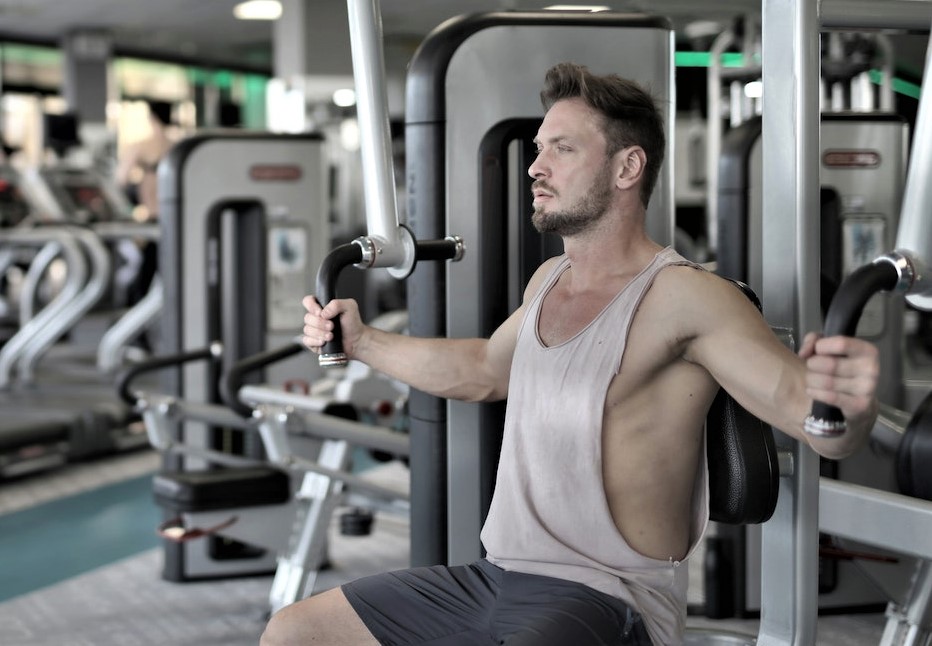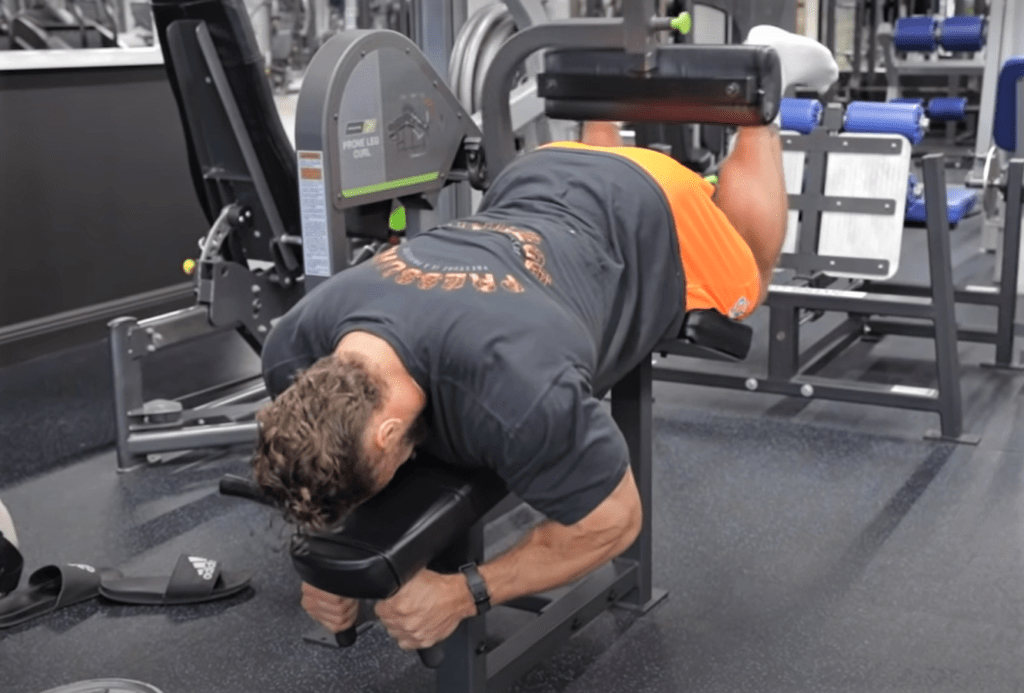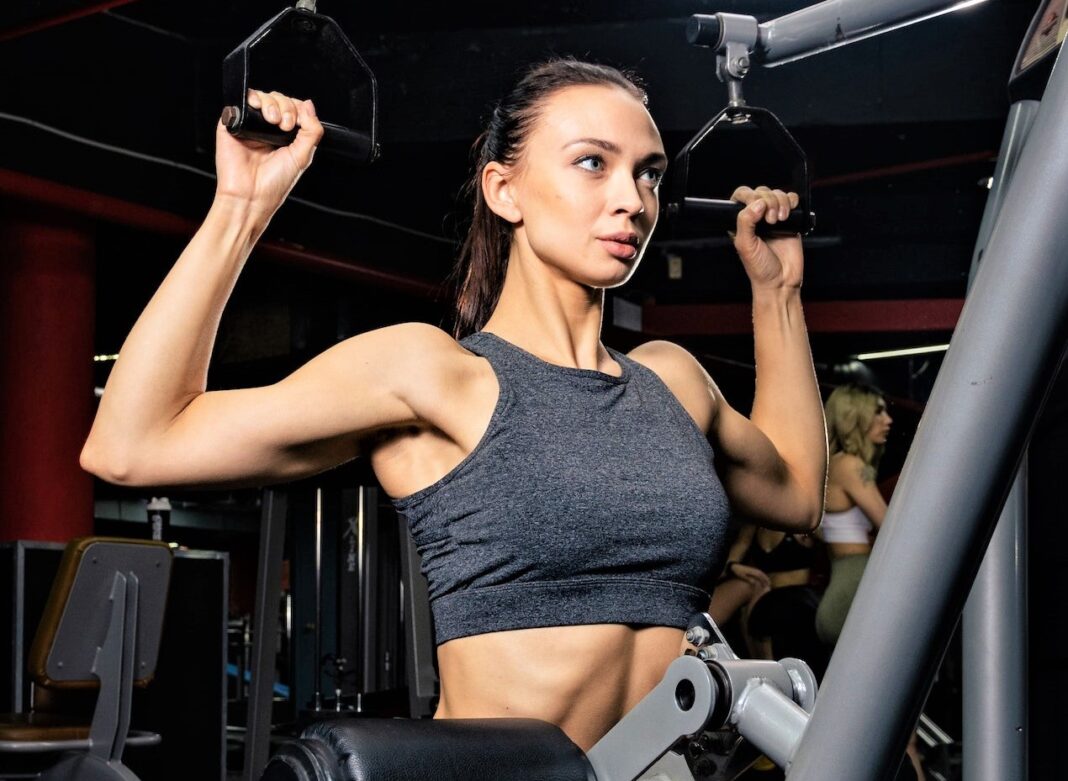Pair pulldowns with overhead presses. / Pexels: Alexa Popovich
Ali versus Frazier, Batman versus The Joker, Lamborghini vs. Ferrari—fierce rivalries bring out the best in both combatants. And sometimes antagonists can join together to double their effectiveness. Think Magic Johnson and Larry Bird on the Dream Team. Your physique is a collection of antagonists, triceps on one side, biceps on the other. By training them in pairs, alternating exercises or sets, you can achieve a synergistic effect that brings out the best in two opposing forces. Let’s explore how to best perform antagonist muscle training.
OPPOSITES ATTRACT
Arnold Schwarzenegger worked chest and back in the same workouts in the ’70s when he was annually expanding his Olympia trophy collection. He liked pumping up the two sides of his torso together. (And still does.) Frequently, he superset them, combining bench presses with pullups and incline presses with T-bar rows. Chest and back is a rare pairing today. Many trainers divide their body into six workouts, so it’s a given they’ll hit chest and back on separate days. Today, the most common antagonistic combo is quadriceps and hamstrings (i.e. leg day) with biceps and triceps (i.e. arm day) a close second. But you can train virtually every major muscle group with its opposite.

Antagonistic muscles oppose the action of each other. When your quadriceps contract, your hamstrings relax and stretch, and when your hams contract, it’s your quads that are taking it easy and elongating. Quads/hams and biceps/triceps are true antagonists, because they share single hinge joints: knees and elbows. Similarly, your ankle joints have opposing calf muscles: the tibialis on the front and the gastrocnemius and soleus at the back. And the wrist joints have opposing forearm muscles: extensors on side, flexors on the other.
Due to the ball-and-socket joints of your shoulders, your pecs and lats are not precise antagonists. However, it still makes sense to pair pushing motions for chest with rowing motions for back, since these are opposing actions. Likewise, flying motions (for chest) can be teamed with rear laterals, sometimes called reverse flyes (for posterior delts). Deltoids also have no true antagonists. However, you can combine overhead pushing movements, like dumbbell shoulder presses, with overhead pulling movements, like pulldowns. We do that in our routines below by pairing back “thickness exercises” (rows) with chest and pairing back “width exercises” (pullups & pulldowns) with shoulders.
Because they move your spine in opposite directions, forward or backward, abdominals can be coupled with lower back in a core routine. Add oblique work for side-to-side spinal contraction.
You can pair not just antagonistic muscles but antagonistic, similar exercises. For example, couple rope pushdowns (for triceps) with rope curls (for biceps and brachialis). In this way, you can do both exercises at the same workout station, either supersetting or doing all the sets for one followed by all the sets for its “opposite.”
PAIR UP
There are several reasons to go antagonistic.
◼ First, working two sides together keeps both warm and stretched.
◼ Second, it boosts the pump by driving more blood into one body part via its neighbor. You’ve never experienced a maximum arm blow-up until you superset biceps and triceps.
◼ Thirdly, it forces you to think of your body as more of a unified whole and less as a collection of parts. If you hit chest with back or have a “width day” in which you combine shoulders with pulldowns, you’ll feel a synergy by doing a movement with its opposite. And you can better incorporate exercises like pullovers for chest/back and lunges for quads/hams, which work both sides together.
◼ The last reason to go antagonistic is to conserve time. Let’s say you currently divide your body into six workouts. The Barbell‘s antagonistic muscle workouts below can be divided into four sessions. You can take three days off each week, or you can cycle through your body more quickly by going four-on, one-off or four-on, two-off. Some people balk at dividing their body into four workouts because individual workouts may be longer. However, the genius of antagonistic training is that you can use your rest periods to work one body part while the other recovers. Our sample chest and back thickness routine has 28 sets, but any of those front/back exercise pairings can be combined without stopping. Your chest will be recuperating as you grind through dumbbell rows face-down on an incline bench, just as your back will be chilling when you flip around and pump out dumbbell inclines. Antagonistic training gives you the ability to do more work in less time.

ANTAGONIST MUSCLE TRAINING BASICS
Train a body part with its antagonist, alternating exercises or sets.
When one muscle is contracting, its opposite is stretching.
Supersetting antagonists is especially effective.
If a body part doesn’t have a true antagonist, focus on opposing movements. For example, overhead pressing (for the shoulders) and pullups or pulldowns (for the lats) contrast extending the arms (up) with retracting the arms (down).
ANTAGONIST MUSCLE TRAINING TIPS
When possible, pair an exercise with its closest counterpart, such as leg extensions with leg curls or barbell rows with barbell bench presses.
Even better: Choose exercises that allow you to work both sides with the same equipment, such as the dumbbell incline press and dumbbell incline row.
Not every exercise has a good counterpart. Deadlifts and lunges, for examples, don’t.
You don’t have to train your entire body this way. Experiment with specific antagonistic muscle workouts.

ANTAGONIST MUSCLE WORKOUTS
The following routines allow you to work every major muscle or muscle group with its antagonist. You can do any of these individual routines for any body part or all of them for your entire body. In the latter case, do four workouts, and work calves after quads/hams on leg day, and forearms after biceps/triceps on arm day, and core on any day(s).
QUADRICEPS/HAMSTRINGS ROUTINE
Leg Extension — 4 x 15 reps
Lying Leg Curl — 4 x 15 reps
Leg Press — 4 x 10-12 reps
Stiff-leg Deadlift — 4 x 15 reps
Hack Squat — 4 x 10-12 reps
Seated Leg Curl — 4 x 10-12 reps
Walking Lunge — 3 x 30 steps
CALF ROUTINE
Standing Calf Raise — 4 x 10-15 reps
Tibialis Raise — 4 x 10-15 reps
Seated Calf Raise — 4 x 10-15 reps
CHEST/BACK THICKNESS ROUTINE
Barbell Bench Press — 4 x 8-12 reps
Barbell Row — 4 x 8-12 reps
Dumbbell Incline Press — 4 x 10-12 reps
Dumbbell Incline Row — 4 x 10-12 reps
Dip — 3 x 10-15 reps
Low-cable Row — 3 x 10-12 reps
Machine Flye — 3 x 10-15
Machine Rear Lateral — 3 x 10-15 reps
SHOULDERS/BACK WIDTH ROUTINE
Seated Military Press — 4 x 8-12 reps
Pullup — 4 x 8-15 reps
Wide-grip Upright Row — 4 x 10-12 reps
Front Pulldown — 4 x 10-12 reps
Dumbbell Side Lateral — 4 x 10-15 reps
Straight-arm Pulldown — 3 x 10-15 reps
Cable Front Raise — 3 x 10-15 reps
Dumbbell Shrug — 4 x 10-15 reps
CORE ROUTINE
Hanging Leg Raise — 4 x 10-15
Back Extension — 4 x 10-15
Incline Curl Up — 4 x 10-15
Side Bend — 4 x 10-15 (per side)
TRICEPS/BICEPS ROUTINE
Lying Triceps Extension — 4 x 10-12 reps
EZ-bar Curl — 4 x 10-12 reps
Two-dumbbell Extension — 4 x 10-12 reps
Two-dumbbell Curl — 4 x 10-12 reps
Pushdown — 4 x 12-15 reps
Cable Curl — 4 x 12-15 reps
FOREARM ROUTINE
Reverse Wrist Curl — 4 x 12-15
Wrist Curl — 4 x 12-15
















































